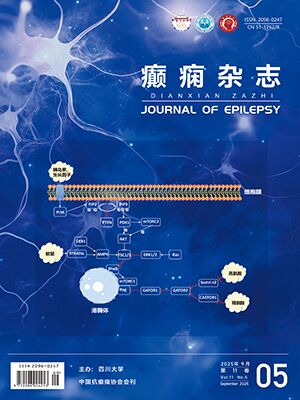| 1. |
van Vliet EA, Aronica E, Vezzani A, et al. Neuroinflammatory pathways as treatment targets and biomarker candidates in epilepsy: emerging evidence from preclinical and clinical studies. Neuropathol Appl Neurobiol, 2017. [Epub ahead of print].
|
| 2. |
Korff CM, Dale RC. The immune system in pediatricseizures and epilepsies. Pediatrics, 2017, 140(3): e20163534.
|
| 3. |
Bargerstock E, Puvenna V, Iffland P, et al. Is peripheral immunity regulated by blood-brain barrier permeability changes?. PLoS One, 2014, 9(7): e101477.
|
| 4. |
Costello DA, Watson MB, Cowley TR, et al. Interleukin-1alpha and HMGB1 mediate hippocampal dysfunction in SIGIRR-deficient mice. J Neurosci, 2011, 31(10): 3871-3879.
|
| 5. |
Pauletti A, Terrone G, Shekh-Ahmad T, et al. Targeting oxidative stress improves disease outcomes in a rat model of acquired epilepsy. Brain, 2017, 140(7): 1885-1899.
|
| 6. |
Walker LE, Frigerio F, Ravizza T, et al. Molecular isoforms of high-mobility group box 1 are mechanistic biomarkers for epilepsy. J Clin Invest, 2017, 127(6): 2118-2132.
|
| 7. |
Fu L, Liu K, Wake H, et al. Therapeutic effects of anti-HMGB1 monoclonal antibody on pilocarpine-induced status epilepticus in mice. Sci Rep, 2017, 7(1): 1179-1191.
|
| 8. |
Zhao J, Wang Y, Xu C, et al. Therapeutic potential of an anti-high mobility group box-1 monoclonal antibody in epilepsy. Brain Behav Immun, 2017, 64: 308-319.
|
| 9. |
Balosso S, Liu J, Bianchi ME, et al. Disulfide-containing high mobility group box-1 promotes N-methyl-D-aspartate receptor function and excitotoxicity by activating Toll-like receptor 4-dependent signaling in hippocampal neurons. Antioxid Redox Signal, 2014, 21(12): 1726-1740.
|
| 10. |
Li Y, Korgaonkar AA, Swietek B, et al. Toll-like receptor 4 enhancement of non-NMDA synaptic currents increases dentate excitability after brain injury. Neurobiol Dis, 2015, 74: 240-253.
|
| 11. |
Vezzani A, Maroso M, Balosso S, et al. IL-1 receptor/Toll-like receptor signaling in infection, inflammation, stress and neurodegeneration couples hyperexcitability and seizures. Brain Behav Immun, 2011, 25(7): 1281-1289.
|
| 12. |
De Simoni MG, Perego C, Ravizza T, et al. Inflammatory cytokines and related genes are induced in the rat hippocampus by limbic status epilepticus. Eur J Neurosci, 2000, 12(7): 2623-2633.
|
| 13. |
Ravizza T, Gagliardi B, Noe F, et al. Innate and adaptive immunity during epileptogenesis and spontaneous seizures: evidence from experimental models and human temporal lobe epilepsy. Neurobiol Dis, 2008, 29(1): 142-160.
|
| 14. |
Balosso S, Ravizza T, Aronica E, et al. The dual role of TNF-alpha and its receptors in seizures. Exp Neurol, 2013, 247: 267-271.
|
| 15. |
Roseti C, van Vliet EA, Cifelli P, et al. GABAA currents are decreased by IL-1beta in epileptogenic tissue of patients with temporal lobe epilepsy: implications for ictogenesis. Neurobiol Dis, 2015, 82: 311-320.
|
| 16. |
Devinsky O, Vezzani A, Najjar S, et al. Glia and epilepsy: excitability and inflammation. Trends Neurosci, 2013, 36(3): 174-184.
|
| 17. |
Prabowo AS, Iyer AM, Anink JJ, et al. Differential expression of major histocompatibility complex class I in developmental glioneuronal lesions. J Neuroinflammation, 2013, 10: 12.
|
| 18. |
Kenney-Jung DL, Vezzani A, Kahoud RJ, et al. Febrile infection-related epilepsy syndrome treated with anakinra. Ann Neurol, 2016, 80(6): 939-945.
|
| 19. |
Stellwagen D, Beattie EC, Seo JY, et al. Differential regulation of AMPA receptor and GABA receptor trafficking by tumor necrosis factor-alpha. J Neurosci, 2005, 25(12): 3219-3228.
|
| 20. |
Lagarde S, Villeneuve N, Trebuchon A, et al. Anti-tumor necrosis factor alpha therapy (adalimumab) in rasmussen's encephalitis: An open pilot study. Epilepsia, 2016, 57(6): 956-966.
|
| 21. |
Roseti C, Fucile S, Lauro C, et al. Fractalkine/CX3CL1 modulates GABAA currents in human temporal lobe epilepsy. Epilepsia, 2013, 54(10): 1834-1844.
|
| 22. |
Fabene PF, Bramanti P, Constantin G. The emerging role for chemokines in epilepsy. J Neuroimmunol, 2010, 224(1-2): 22-27.
|
| 23. |
Louboutin JP, Chekmasova A, Marusich E, et al. Role of CCR5 and its ligands in the control of vascular inflammation and leukocyte recruitment required for acute excitotoxic seizure induction and neural damage. FASEB J, 2011, 25(2): 737-753.
|
| 24. |
Cerri C, Genovesi S, Allegra M, et al. The chemokine CCL2 mediates the seizure-enhancing effects of systemic inflammation. J Neurosci, 2016, 36(13): 3777-3788.
|
| 25. |
Wyatt SK, Witt T, Barbaro NM, et al. Enhanced classical complement pathway activation and altered phagocytosis signaling molecules in human epilepsy. Exp Neurol, 2017, 295: 184-193.
|
| 26. |
Aronica E, Boer K, van Vliet EA, et al. Complement activation in experimental and human temporal lobe epilepsy. Neurobiol Dis, 2007, 26(3): 497-511.
|
| 27. |
Kharatishvili I, Shan ZY, She DT, et al. MRI changes and complement activation correlate with epileptogenicity in a mouse model of temporal lobe epilepsy. Brain Struct Funct, 2014, 219(2): 683-706.
|
| 28. |
Benson MJ, Thomas NK, Talwar S, et al. A novel anticonvulsant mechanism via inhibition of complement receptor C5ar1 in murine epilepsy models. Neurobiol Dis, 2015, 76: 87-97.
|




